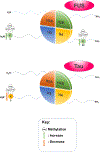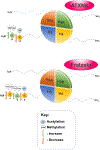The impact of histone post-translational modifications in neurodegenerative diseases
- PMID: 30352259
- PMCID: PMC6475498
- DOI: 10.1016/j.bbadis.2018.10.019
The impact of histone post-translational modifications in neurodegenerative diseases
Abstract
Every year, neurodegenerative disorders take more than 5000 lives in the US alone. Cures have not yet been found for many of the multitude of neuropathies. The majority of amyotrophic lateral sclerosis (ALS), frontotemporal dementia (FTD) and Parkinson's disease (PD) cases have no known genetic basis. Thus, it is evident that contemporary genetic approaches have failed to explain the etiology or etiologies of ALS/FTD and PD. Recent investigations have explored the potential role of epigenetic mechanisms in disease development. Epigenetics comprises heritable changes in gene utilization that are not derived from changes in the genome. A main epigenetic mechanism involves the post-translational modification of histones. Increased knowledge of the epigenomic landscape of neurodegenerative diseases would not only further our understanding of the disease pathologies, but also lead to the development of treatments able to halt their progress. Here, we review recent advances on the association of histone post-translational modifications with ALS, FTD, PD and several ataxias.
Keywords: Amyotrophic lateral sclerosis; Epigenetics; Friedreich's ataxia; Frontotemporal dementia; Histones; Neurodegeneration; Neurodegenerative disease; Parkinson's disease; Post translational modifications; Spinocerebellar ataxia.
Copyright © 2018 Elsevier B.V. All rights reserved.
Figures




References
Publication types
MeSH terms
Substances
Grants and funding
LinkOut - more resources
Full Text Sources
Medical
Miscellaneous

